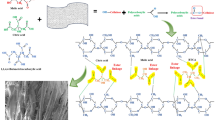Abstract
Phenolic compounds found in many plant-based natural antioxidants inhibit pathogenic growth and are not normally toxic to humans. Therefore, in this study we treated cotton and wool fabrics with phenolic compounds through a pad-dry-cure process and investigated the mechanical properties, antibacterial ability, and antioxidant ability of the fabric samples. Polycarboxylic acid was used to cross-link the phenolic compounds to cellulose, whereas wool fabric did not need a cross-linker because the phenolic compounds easily bond to protein naturally. Consequently, both the cotton and wool fabric samples treated with phenolic compounds revealed excellent antibacterial ability against gram-positive bacteria (>99.9 %) as well as gram-negative bacteria (>99.5). However, with regard to the antioxidant ability, all of the wool fabrics treated with phenolic compounds showed significant antioxidant ability (>90 %); however, the antioxidant ability of most of the cotton fabrics treated with phenolic compounds were insufficient (>35 %). This suggests that the cotton fabrics treated with phenolic compounds lost their hydroxyl groups by cross-linking with polycarboxylic acid, causing phenolic moieties also to lose their antioxidant function.
Similar content being viewed by others
References
Transparency Market Research, Technical Textiles Market-Global Industry Analysis, Size, Share, Growth, Trends and Forecast 2012–2018 (access on December 2014).
Y. S. Shin, M. Choi, and D. I. Yoo, Fashion and Textiles, 1, 6 (2014).
R. Purwar and M. Joshi, AATCC Rev., 4, 22 (2004).
B. Simoncic and B. Tomsic, Text. Res. J., 80, 1721 (2010).
L. Windler, M. Height, and B. Nowack, Environ. Int., 53, 62 (2013).
J. H. Park, K. W. Oh, and H. M. Choi, Cellulose, 20, 2101 (2013).
K. W. Oh, H. M. Choi, J. M. Kim, J. H. Park, and I. S. Park, Text. Res. J., 84, 808 (2014).
S. A. Blaser, M. Scheringer, M. MacLeod, and K. Hungerbuehler, Sci. Total Environ., 390, 396 (2008).
A. B. Dann and A. Hontela, J. Appl. Toxicol., 31, 285 (2011).
T. Madsen, L. Samsøe-Petersen, K. Gustavson, and D. Rasmussen, “Ecotoxicological Assessment of Antifouling Biocides and Nonbiocidal Antifouling Paints”, Environmental Project No. 531, Danish Environmental Protection Agency, Hørsholm, Denmark, 2000.
G. Jeong, L. Lee, and D. Park, Korean Chem. Eng. Res., 44, 81 (2006).
E. Yi and E. Yoo, Text. Res. J., 80, 2117 (2010).
N. F. Ali and R. S. R. El-Mohamedy, J. Saudi Chem. Soc., 15, 257 (2011).
B. Ben-Fadhel, A. Aissi, N. Ladhari, R. Deghrigue, and J. P. Joly, J. Text. Inst., 103, 1197 (2012).
K. H. Hong, J. H. Bae, S. R. **, and J. S. Yang, Cellulose, 19, 507 (2012).
M. Mercado-Feliciano, R. A. Herbert, M. E. Wyde, D. K. Gerken, M. R. Hejtmancik, and M. J. Hooth, Cutan. Ocul. Toxicol., 32, 234 (2013).
Material Safety Data Sheet, https://www.msds.com/ (access on 3 July 2014).
J. Han, X. C. Weng, and K. S. Bi, Food Chem., 106, 2 (2008).
M. S. M. Alger, “Polymer Science Dictionary”, p.152, Springer, London, 1997.
W. D. Loomis and J. Battaile, Phytochemistry, 5, 423 (1966).
H. S. Mason, Nature, 175, 771 (1955).
A. E. Hagerman and L. G. Butler, J. Agric. Food Chem., 26, 809 (1978).
M. I. Rubino, S. D. Arntfield, C. A. Nadon, and A. Bernatsky, Food Res. Int., 29, 653 (1996).
W. Vermerris and R. Nicholson, “Families of Phenolic Compounds and Means of Classification”, p.48, Phenolic Compound Biochemistry, Springer, The Netherlands, 2006.
C. Q. Yang, Text. Res. J., 61, 298 (1991).
D. L. Pavia, G. M. Lampman, and G. S. Kriz, “Introduction to Spectroscopy”, 2nd ed., p.54, Saunders College Publishing, Washington, US, 1996.
S. H. Hsieh, Z. K. Huang, Z. Z. Huang, and Z. S. Tseng, J. Appl. Polym. Sci., 94, 1999 (2004).
I. A. Janković, Z.V. Šaponjić, E. S. Džunuzović, and J. M. Nedeljković, Nanoscale Res. Lett., 5, 81 (2010).
X. Zhang and M. D. Do, Carbohydr. Res., 344, 1180 (2009).
R. A. Frazier, E. R. Deaville, R. J. Green, E. Stringano, I. Willoughby, J. Plant, and I. Mueller-Harvey, J. Pharm. Biomed. Anal., 51, 190 (2010).
E. Koh and K. H. Hong, Dyes Pigment., 103, 222 (2014).
M. Orhan, D. Kut, and C. Gunesoglu, J. Appl. Polym. Sci., 111, 1344 (2009).
Wikipedia, http://en.wikipedia.org/wiki/Bacteria (access in March 2013).
J. M. Starr and R. J. Starr in “Aging: Oxidative Stress and Dietary Antioxidants: Skin Aging and Oxidative Stress”, (V. Preedy Ed.), 1st ed., pp.15–22, Elsevier, MA, US, 2014.
C. Alonso, M. Martí, V. Martínez, L. Rubio, J. L. Parra, and L. Coderch, Eur. J. Pharm. Biopharm., 84, 192 (2013).
Y. R. Lu and Y. L. Foo, Food Chem., 75, 197 (2001).
Author information
Authors and Affiliations
Corresponding author
Rights and permissions
About this article
Cite this article
Hong, K.H. Phenol compounds treated cotton and wool fabrics for develo** multi-functional clothing materials. Fibers Polym 16, 565–571 (2015). https://doi.org/10.1007/s12221-015-0565-0
Received:
Revised:
Accepted:
Published:
Issue Date:
DOI: https://doi.org/10.1007/s12221-015-0565-0




